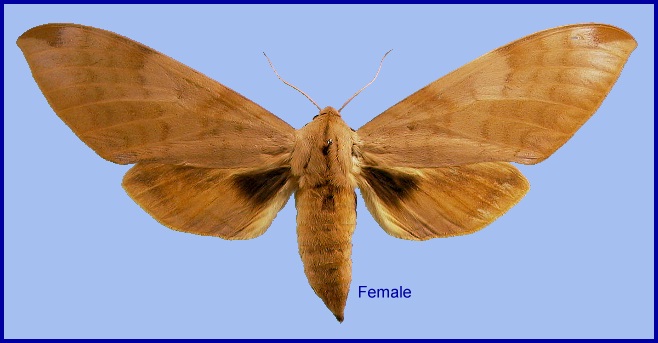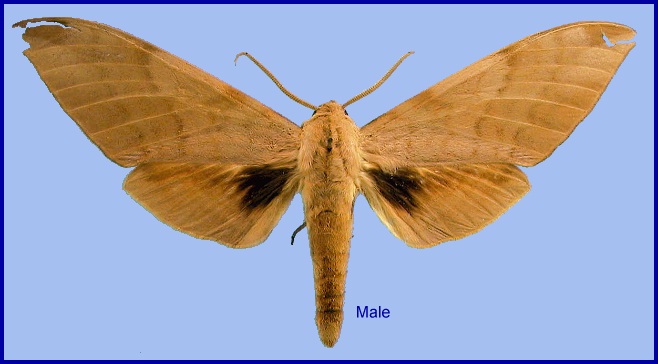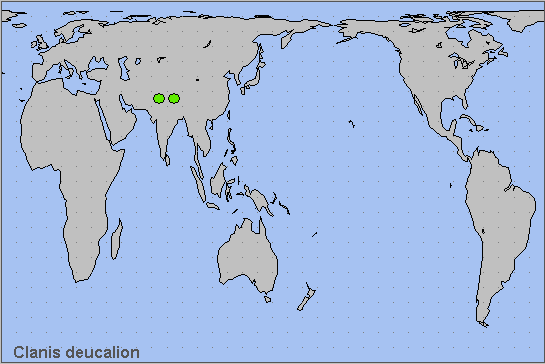

Basiana deucalion Walker, 1856, List Specimens lepid. Insects Colln Br. Mus. 8: 236. Type locality: North India.
Synonym. Basiana deucalion Walker, 1856.
Wingspan: 104--124mm. In colour closely resembles Clanis undulosa, with which it agrees in the mid-tibia not being white above like the hind tibia, and in the presence of a black streak on underside of forewing. Differs from Clanis undulosa in the forewing upperside having three sharply marked dentate lines on discal area, equidistant from each other and from cell and the postdiscal, indistinct line which begins at the apical patch; no pale line before M3 and no pale costal area. The black patch on hind wing more restricted, longer at 2A+3A than at M3; tawny-brown scales between this patch and apex of wing. Forewing less elongate than in Clanis undulosa; hind tibia as long as first tarsal segment, and this barety longer than 2 to 5 together; terminal pair of spurs very unequal, shorter than in Clanis undulosa, the long one only half length of first tarsal segment (Bell & Scott, 1937). Antennae white, never pinkish as in Clanis undulosa.
Adults are attracted to light, but do not feed (Bell & Scott, 1937).
China: Unknown.
OVUM:
LARVA: Full-fed 75--100mm. In the final instar, head large, broadly rounded-triangular, with a large rounded tubercle on apex of each lobe. Clypeus acutely triangular, about one-third length of head; labrum long and very narrow. Surface of head moderately shiny, covered with low, rounded, shiny tubercles. Body short and thick, nearly cylindrical. Horn very short, thick at base and tapering sharply to a blunt point. Surface of body dull with one or two transverse rows of tubercles around each secondary ring, these tubercles larger and more closely set on the front margin of segment 2. There is a subdorsal stripe of large tubercles on segments 2 to 4, and a line of tubercles along each oblique stripe, those on stripes 8 to 9 of equal size, those on stripe 10 very small, and those on stripe 11 larger than those on stripes 8 to 9. Horn covered with pointed tubercles. There is a line of tubercles at base proleg ankle (Bell & Scott, 1937).
In colour, head bright green with shiny yellow tubercles. A broad bright blue stripe runs from the apex of each lobe to the base of the antenna, separating face from cheek. The labrum translucent yellow; ligula and base of mandible yellow; tip of mandible black; basal segment of antenna yellow, the remaining segments pale chestnut; eyes black. Body pale green, the tubercles yellow. The oblique lateral stripes are narrow, yellowish-green, each crossing two segments and reaching nearly to the dorsal line; the tubercles on the stripes yellow. Horn green with green tubercles. True legs pale flesh-colour, a reddish ring at the base of each, theend-segment reddish. Prolegs and claspers green, the tubercles at base of ankles chestnut, feet pale reddish-brown. Spiracles oval, reddish with a white stripe down each side of the central slit (Bell & Scott, 1937).
There is another form of the larva in which the ground colour is yellow instead of green, with a triangle of pale purple above each oblique lateral stripe, and with a broad, pale purple, subspiracular stripe crossed.
Diapauses underground as a dormant larva, the moths emerging in the spring two or three weeks after actual pupation takes place (Bell & Scott, 1937).
PUPA: 55mm.; width 22mm. Colour a fine chestnut, bevels of movable segments paler, spiracles and cremaster black. Large, slender and shiny; length from front of pupa to end of wing-cases more than rest of pupa. Frons broadly visible from below; antenna shorter than fore leg; often with a distinct coxal piece. Frons shallowly rugose-corrugate, base of tongue minutely transverse-corrugate; costa and veins of wing obscurely beaded. Segments 4-7 with a single row of deep pits along the front margin; strong antespiracular ridges on segments 9-11; a very small spiracle visible on segment 5. Abdomen shagreened. Cremaster wedge-shaped, upturned, the lower edge of base touching clasper-scars on 14; its surface very rugose and corrugate, excepting the narrow longitudinal ridge at the end, which is smooth and shiny (Bell & Scott, 1937).
Larval hostplants. Principally on the introduced North American tree Robinia pseudoacacia.
Unknown.
China: ?Liaoning; ?Jiangsu; ?Anhui (Mt. Huang Shan); ?Zhejiang (Tianmu Shan); ?Hubei (Hefeng); ?Sichuan; south Xizang/Tibet (Nyingchi/Linzhi, Namjagbarwa region, 3050m (Wang, 1988); XigazÍ/Rikaze/Shigatse Prefecture); ?Hunan (Dayong); ?Fujian (Longqi Shan).
From northern Pakistan (Rafi et al., 2014; Haxaire, Gujjar & Saeed, 2017), northern India (including Himachal Pradesh and Sikkim) and Nepal to Xizang/Tibet, China. All other records for China are dubious and may be based on misidentifications of either Clanis bilineata or Clanis undulosa.

 Return to Sphingidae of the Eastern Palaearctic species list
Return to Sphingidae of the Eastern Palaearctic species list